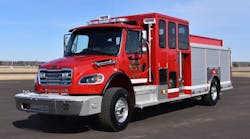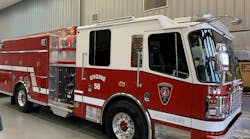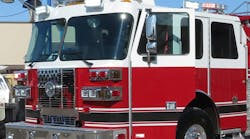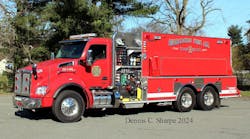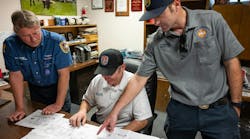This column will examine a National Institute for Occupational Safety and Health (NIOSH) report on an incident that occurred in Oklahoma in 1999. The incident caused the death of one firefighter and injuries to a second firefighter and a civilian. All three were struck by a motor vehicle that went out of control on a wet, busy interstate highway.
The fire department involved in the incident serves a population of 58,000 in a 26.5-square-mile area. It is also responsible for a three-mile section of the interstate highway on which the incident occurred.
The fire department requires all new firefighters to receive International Fire Service Training Association (IFSTA) training and certification. Each firefighter is also trained and certified as an emergency medical technician (EMT).
At 7:20 P.M. on Aug. 5, 1999, a call came into Central Dispatch reporting a single-vehicle crash (car 1) on the westbound side of the interstate. The highway was wet and slippery after intermittent rainstorms. Units responding included Ladder 2 (with a captain and two firefighters), Squad 2 (two firefighters) and one privately owned ambulance. Squad 2 was the first unit to on scene, at 7:23, and reported no injuries. Squad 2 personnel then released the ambulance.
At about the same time, Ladder 2 stopped near the median wall (see diagram) approximately 150 yards directly behind Squad 2 to provide better protection from oncoming traffic for the occupant of the car and the Squad 2 firefighters. The Ladder 2 crew remained in the truck, with emergency lights operating, while the captain called dispatch for an estimated time of arrival of the Oklahoma Highway Patrol.
Suddenly, at 7:26, Ladder 2 was struck from behind by a private vehicle (car 2). As the Ladder 2 crew exited the truck to see if there were any injured motorists, they noticed the driver getting out of the car. She complained of a sore ankle, so they began to check her for injuries. The captain notified dispatch that the ladder truck had been struck from behind by a car, and requested that EMS return to the scene and assist the injured driver. He then asked the city police to respond to the scene to provide traffic control; the highway patrol had told fire dispatch that due to numerous accidents it could not provide a timely response.
Seeing that Ladder 2 had been struck by the car, a firefighter from Squad 2 ran up the hill to check on the Ladder 2 crew and provide assistance. The Ladder 2 crew and the Squad 2 firefighter assisted the driver of car 2 back to the seat of her car so they could attend to her ankle injury. The captain then began to walk eastbound on the inside lane of the westbound highway to flag traffic away from the incident.
At this time, the firefighter directing traffic near Squad 2 saw another vehicle (car 3) cresting the top of the overpass on the inside lane and rapidly approaching Ladder 2. He yelled out two warnings over the radio - "Ladder 2 captain, watch out behind you!" just as the driver of the car lost control. The captain turned and yelled to the other firefighters near Ladder 2, "Watch out, watch out!" At that moment, the firefighter from Ladder 2 and the firefighter from Squad 2 started to move the injured driver from car 2 toward a safe area in front of the ladder truck.
Car 3 spun backward, striking the median wall approximately 20 yards east of Ladder 2. The car slid between the wall and Ladder 2, missing the captain and a firefighter from Ladder 2 before striking two of the firefighters and the injured driver from car 2.
The captain and the firefighter from Ladder 2 escaped injury by diving over the median wall onto the eastbound highway. The firefighter from Squad 2 was positioned between the injured driver and car 3 when they were struck. The impact threw the injured driver to the ground in front of Ladder 2 (a distance of 47 feet from the point of impact) and threw the firefighter from Squad 2 over the top of Ladder 2, causing the fatal injuries. He landed near the front of the unit.
The second firefighter from Ladder 2 was struck by the car and thrown over the median wall (onto the inside eastbound lane of the highway). The uninjured firefighter from Ladder 2 moved the injured firefighter out of the path of oncoming traffic and began administering basic life support. The captain jumped back over the wall to check on the condition of the fatally injured firefighter and the driver of car 3.
At 7:27, dispatch was notified of "firefighters down" and requested additional medical and police assistance. A second alarm was struck, and Engines 1 and 3, Squad 1 and Shift Commander 203 responded to the scene. The firefighter who had been directing traffic near Squad 2 ran up the hill to check on both the civilian driver from car 2 and the fatally injured firefighter from Squad 2. He administered emergency medical treatment to the Squad 2 firefighter while the captain attended to the driver from car 2. The captain assessed that the civilian driver from car 2 was not in an immediate life-threatening condition, so he proceeded to the back of the ladder truck to check the driver of car 3 for injuries. The driver of car 3 told the captain that he was all right, and he did not appear to have any serious injuries. The captain went to assist the firefighter from Ladder 2 in treating the Squad 2 firefighter, who was not breathing and in need of an oral airway.
While the captain obtained a trauma kit, a fourth vehicle (car 4) struck car 2 from behind. The captain immediately went to check the occupants of car 4. An ambulance arrived in the eastbound lane and its crew was assisting in the treatment of the injured firefighter from Ladder 2. The captain found no serious injuries to the occupants of car 4, so he asked them to "sit still" because additional help was on the way. As additional personnel arrived, they assisted in traffic control and in preparing the injured firefighter from Ladder 2 and the fatally injured firefighter from Squad 2 for transport to the hospital. The driver from car 2 was also transported to the hospital.
I would like to thank NIOSH for providing information and assistance for this column. NIOSH reports on his or other firefighter fatalities are available at www.cdc.gov/niosh/firehome.html. Michael Wilbur, a Firehouse® contributing editor, is a lieutenant in the New York City Fire Department, assigned to Ladder Company 27 in the Bronx, and has served for the past five years on the FDNY Apparatus Purchasing Committee. He has consulted on a variety of apparatus-related issues throughout the country.


